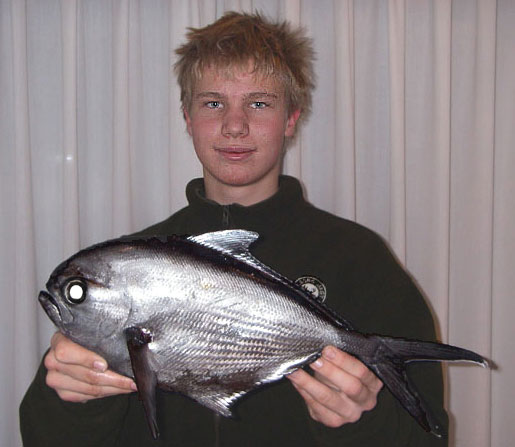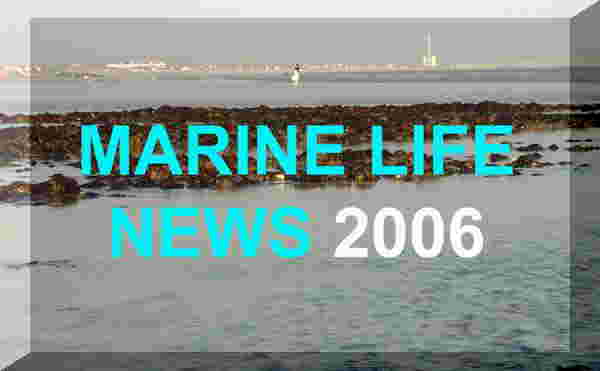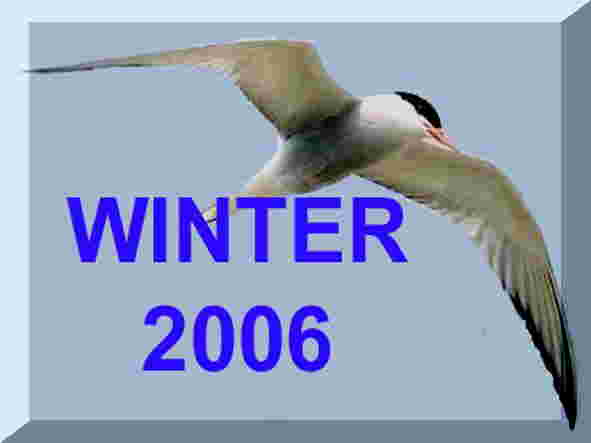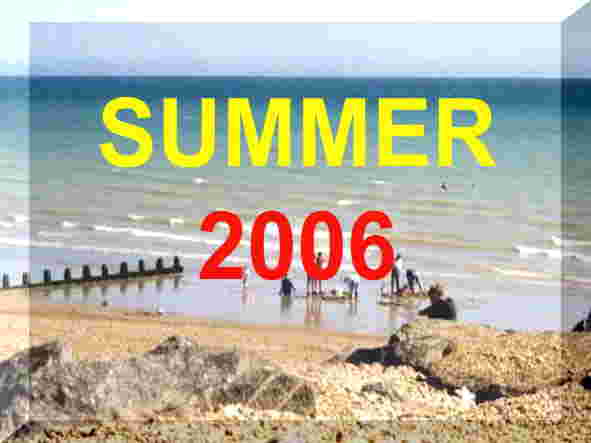WILDLIFE
REPORTS
28
December 2006
A
Ray's
Bream,
Brama
brama, was caught by angler Sören
Linnemann, off north-east Denmark. It weighed
1.2 kg with a total length (including caudal fin) of 50 cm.
|
 |
18-20
December 2006

A scour
of the strandline between Sennen
and Gwenver on the
west coast of Cornwall near Land's End discovered about fifty Violet
Sea Snails,
Janthina, seven dead
Triggerfish,
Balistes
capriscus. and one Gulfweed
Crab, Planes minutus, on a polystrene
float covered with Goose Barnacles,
and two Ray egg cases.
19
November 2006
An
extraordinary report of an Oceanic Pufferfish,
Lagocephalus
lagocephalus, discovered washed up
dead on the shore by Christopher and Morwenna
Smart at Treyarnon
Bay, near Padstow,
on the north coast of Cornwall.
"At
first I thought it was a plastic toy fish, but then realised it was real
and so we carried it home in an old fishbox we found. It was a really beautiful
fish, blue, silver and white with a green stripe through its eye and quite
different from fish we normally see around here."
There
were also By-the-Wind Sailors, Velella
velella, washed up.
This
is the first confirmed report of an Oceanic
Pufferfish, Lagocephalus lagocephalus,
on
these Marine Life News web
pages. There have been unconfirmed
reports of live ones seen briefly by divers. This fish is a common
pelagic species of sub-tropical and tropical seas worldwide.

17
December 2006
Twenty
Violet
Sea Snails,
Janthina, were discovered
along the beach at Woolacombe,
North Devon. Most were about 10 mm in size, and some were still alive with
their bubble rafts and "inked" when placed in a bucket. They were
washed in with tiny (max 12 mm) By-the-Wind Sailors, Velella
velella, Buoy Barnacles,
Dosima
fascicularis, and a small 15 cm Triggerfish,
Balistes
capriscus.
BMLSS
Beachcombing
16
December 2006
A
badly decomposed Leatherback Turtle,
Dermochelys
coriacea, was washed ashore on Selsey
beach, West Sussex. It is extremely unusual
for a turtle up this far east up the English
Channel on the northern coast.
Report
by Justin Atkinson
via Ivan Lang (West Sussex
CC)
Full
Report and Image
14
December 2006
At
Sennen,
Cornwall, two species of Violet Sea-snails,
Janthina
janthina and Janthina
pallida, as well as two sea
beans Entada gigas
and Caesalpina bondoc
were discovered on the strandline.

Chinese
Mitten Crabs, Eriocheir
sinensis, have been confirmed as by-catch
from white fish fisheries in the Dee
estuary, north-west Wales.
The
alien Mitten Crabs were probably accidentally
introduced in ballast water and have become established in the
Thames and adjoining rivers and in the Mersey estuary.
They cause a huge amount of damage to the tidal and lower freshwater sections
of rivers as they burrow into riverbanks causing them to collapse and silt
up. Further pressure is also put on our wildlife as these crabs out compete
native species. These crabs must spend the juvenile part of their life
cycle in freshwater but must return to the sea to breed.
BMLSS
Crabs of the Seashore

Another
Columbus
Crab,
Planes minutus, was discovered
by crab potter Chris Marquis
near
Herm and Sark in the Channel Islands amongst a tray of Goose Barnacles.
13
December 2006
The
gales of the preceding week also brought in the remains of a Leatherback
Turtle,
Dermochelys coriacea, on
to at Widemouth
Bay near Bude in north Cornwall.
BMLSS
Turtles
12
& 13 December 2006
On
the shore at Upton
Towans (near Hayle), Cornwall, three Gulfweed
Crabs, Planes minutus, (also known as the Floating Crab and
Columbus Crab) were discovered living among
Goose
Barnacle bases on a polystyrene float;
and on the second day at Perranporth
six of these tiny crabs were found on a plastic barrel and one on a plastic
float.
Earlier
Crab Report
December
2006
Two
deep
water sea stars were recorded and collected
by a ROV submersible, the first a beige species with short arms (like a
cushion star) from a depth of around 250 metres off west Norway, and the
second similiar one from a depth of 600 metres in a Norwegian fjord at
an earlier date. Neither of these species have been positively identified
at time of writing.
Full
Report with the Links to Images
The
species are suggested as Peltaster placenta
and
Diplopteraster
multipes.
BMLSS
Echinoderms
12
December 2006
A
large 20 kg Ocean
Sunfish,
Mola mola, was
washed up dead on the north
Kent coast. The height of this round fish was measured at 98 cm (including
the fins). Sunfish
are frequently found stranded on the western and southern coasts of Britain,
but much less often on North Sea coasts.
Full
Report
11
December 2006
A
surprising discovery of an Ocean Sunfish,
Mola
mola, from the Baltic coast
ofsouthern Sweden, means this fish must have navigated through the narrow
parts of the Kattegat. It was a smallish specimen with a total length of
60 cm.
BMLSS
Sunfish
1
- 9 December 2006
The
prevailing winds of autumn and the recent gales have washed more unusual
pelagic animals on to the shore (with the millions
of By-the-wind Sailors, Velella velella,
and multiple thousands of Goose Barnacles,
Lepas
anatifera) notably the small (size
of a 10 pence piece) pelagic Columbus Crabs,
Planes
minutus, with five discovered on the Dorset
coast at Southbourne (near Bournemouth)
and a further 15 at Hengistbury
Head, Dorset. The latter was discovered inside a large shipworm-riddled,
Teredo,
pole in cavities created by the tiny burrowing mollusc.
The Columbus Crabs were
found with the Goose Barnacles
and there are clues that the buoys, wooden pallets, fish boxes etc. have
been floating around the Atlantic Ocean for two years or more and are American
in origin. The live crabs were placed in the aquarium at the Foundation
Marine Centre at Kimmeridge.
These
crabs are rarely recorded pelagic life with British records only from the
extreme west coasts, with the only Cornish records of the crab coming from
the 19th century.
Planes
minutus is also called the Gulf-weed
Crab because the largest population of this
abundant crab is believed to inhabit the open Atlantic Ocean area known
as the Sargasso Sea.
Previous
Report from the Channel Islands
Previous
Report from Belgium
2
December 2006
My
dog discovered a strange fish partially buried on the North
Gare Sands, Hartlepool, (near the power station) part of the Teesmouth
National Nature Reserve; the fish was one metre long, 30 cms wide and
laterally very thin with a tapering tail. I have identified this fish as
a Deal Fish,
Trachipterus
arcticus.
The Deal
Fish is a deep sea fish which very occasionally
is washed up on the shore.
Previous
Report
November
2006
At
least two specimens of the large pelagic swimming crab known as Henslow's
Swimming Crab, Polybius henslowii,
were
brought in by a commercial fisherman from Poole Bay. This
crab is an active predator of small fish and is usually found over deep
water further south. The same weather conditions which have brought in
the By-the-wind Sailors are
likely to have blown this crab into the shallow bay.
BMLSS Crabs
Velella
on Eastern Green, between Penzance and Long
Rock, Cornwall
Photographs
by Paul Semmens
26
November 2006
Thousands
of By-the-wind
Sailors, Velella velella, were washed
up on Welsh beaches, notably a narrow but continuous line of Velella
velella washed up on the high tide mark at Borthwen,
Rhoscolyn, Anglesey (southern end of Ynys Cybi - Holy Island), north
Wales (Ian
Wright); literally thousands stranded
on a small bay at the Mumbles, Swansea (Jess
Pitman); a swarm amounting to about two
hundred were washed up on Porthllysgi beach off the coast of St.
Davids in south west Wales (Eleri
Davies) with hundreds, possibly thousands,
stranded and dead on the pebbles on the nearby Newgale Beach (Helen
Lee); thousands, if not millions, of By-the-wind
Sailors were washed up on a beach at Criccieth
(on the southern coast of the Lleyn Peninsula), Gwynedd, north Wales (Eilir
Daniels); and an armada, a thick layer
of jellyfish about a metre thick on the strandline in both directions at
Cefn
Sidan Beach at Pembrey, south west Wales (Bella).
BMLSS
Velella
 |
 |
24
November 2006
Reports
of By-the-wind Sailors, Velella velella,
have been received from north Devon and Guernsey.
19
November 2006
A
large number, probably several hundred, of By-the-wind Sailors,
Velella
velella, were washed up on beach at Newborough,
on the southern cost of the Isle of Anglesey, north Wales.
18
November 2006
Thousands
of By-the-wind Sailors,
Velella velella, were reported being
washed up on Saunton,
Croyde and Woolacombe beaches in North Devon. All were noted as being of
the same size, whereas in the past some had been tiny (finger nail size
and smaller) plus larger colonies, all of the recent colonies were 50 -
75 mm across.
9
November 2006
A
Tadpole
Fish, Raniceps raninus, was caught
from Bangor Pier, Co. Down, Northern Ireland. It was returned to the sea
alive.
Image
(link)
BMLSS
Tadpole Fish
7 &
9 November 2006
Two
late in the year Basking Sharks, Cetorhinus
maximus, were reported (by the BBC) off Teignmouth
and the second one off Salcombe, south Devon.
2
November 2006
After
a period of warm southerly and south-westerly winds, the weather changed.
Strong colder winds came from the north-east and an easterly direction.
By-the-wind
Sailors, Velella velella, entered St. Peter Port harbour on
Guernsey's east coast, driven in by the wind. Commercial fisherman
Clive
Brown called to tell me that about 25 Velella
velella were washed up on the shore near his dinghy in the harbour.
I went down to the Albert marina and I was able to collect four Velella
velella by reaching out from a pontoon. This
picture shows one of them mirrored by the water's surface:

Velella
Report
& Photograph by Richard
Lord (Guernsey)
Sealord
Photography
31
October 2006
Tens
of thousands of By-the-wind Sailors,
Velella
velella, were wrapped up in the Thongweed
and Zostera Eelgrass
on Porth Hellick Beach, St. Mary's, Isles of Scilly. I heard they
had also come ashore on other beaches on the east of the island. They were
still quite fresh, though dead.
Images
25 October
2006
I
was approximately 5 to 6 miles west of the Casquettes, off Alderney, Channel
Islands, and I saw about ten Velella velella being blown
past our boat in a few minutes.
BMLSS
Velella
20
October 2006
A
Louvar,
Luvarus
imperial, a large deep sea fish, was caught
by a Swedish angler in northern Norway.
16
October 2006
A
juvenile Northern Bottle-nosed Whale, Hyperoodon
ampullatus, was seen washed in shallow
water on the east side of Inverness,
north-east Scotland. It became stranded on the shore and died within two
hours of first being spotted.
c.
13 October 2006
Sport
angler Anton Kristiansen
was out fishing with Turid Kvammen
at Smøla, off the coast of Nordmøre, northwest Norway when
he hooked and landed a Bluntnosed Six-gilled
Shark, Hexanchus griseus, called
kamtannhai
in
Norwegian. It measured 2.5 meters long and weighed 120 kg (264 lb).
This
shark is a large deep water predatory species that is rarely caught by
commercial fishermen and even less often by anglers. The British Isles
record
angling catch was caught off Ireland. Hexanchus
griseus have six gill slits (the majority
of sharks have only five gill slits) and with only one dorsal fin set near
the tail it is most distinctive.
BMLSS
Sharks
BMLSS
6-gilled Sharks
BMLSS
Shark News
6 October
2006
Fisherman
David
Gillingham caught a rare off-white Lobster,
Homarus
gammarus, off Alderney
in the Channel Islands (English Channel). The Lobster
was white on its underside with grey-green markings on its back and blue
claws which were not as bright blue as usual. It was flown by air to Guernsey
Aquarium which will be its new home.
BMLSS
Abnormal Lobsters
2 October
2006 6:45 to 6:55 am
A
whirlwind
for seen for several minutes off Brighton beach, Sussex. The reports said
it was not a waterspout as the funnel cloud did not reach the sea.
Eyewitness:
Peter Machin
These
lesser whirlwinds occasionally occur and I have been caught up in one.
They are not caught on camera very often.
Tornado
(definition)
Marine
Life off Sussex
Twisters
from Caithness (Images)























